Microsoft Surface Pro 3 Review
by Anand Lal Shimpi on June 23, 2014 3:55 AM ESTBattery Life
Microsoft made no sacrifice in battery capacity in pursuit of Surface Pro 3's thin chassis design. The new tablet features an integrated 42Wh battery just like the previous two models. Charging duties are handled by an external 31W charger with a brand new magnetic connector. Microsoft never seemed to get a good MagSafe clone working in the previous models, so Surface Pro 3 abandons the previous design entirely in favor of something a bit more sensible.
The new connector no longer looks like an oversized MagSafe connector, and instead features a thin plastic insert that mates with the charge port on Surface Pro 3. Charge time hasn't changed, you can fully charge the device in around 2.62 hours:
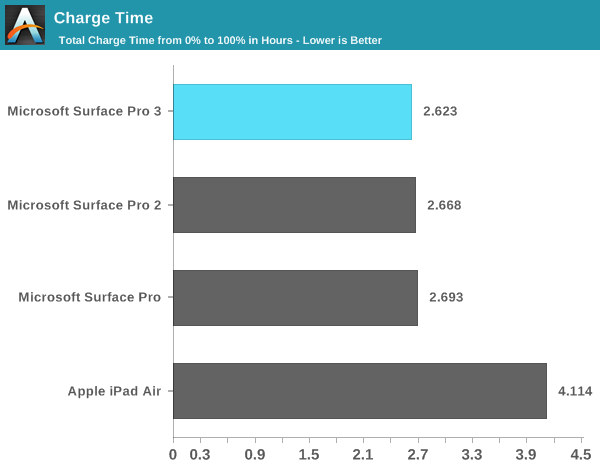
The device-side connector features 40 pins but you only need 12 of them to charge the device. The remaining pins are used for Gigabit Ethernet, USB, DisplayPort (up to 4096 x 2304) and audio. Microsoft seems hell bent on avoiding Thunderbolt at all costs so instead of embracing the standard it has created a custom alternative of its own doing. The benefit to Microsoft's connector is it can obviously deliver more power than Thunderbolt can, the downside is that it can't send PCIe and thus you don't get support for any ultra high bandwidth external storage devices. I still would rather see Microsoft implement Thunderbolt as there's at least an existing ecosystem built around that but here we are three generations into Surface and if we haven't seen it by now I don't think we're ever going to.
The supplied power adapter includes a USB charge port capable of delivering 1A at 5V.
As Surface Pro 3 is designed to be both a laptop and a tablet I've run it through both our Windows laptop battery life tests and our tablet battery life tests.
Laptop Battery Life
As a laptop, Surface Pro 3 delivers comparable battery life to other optimized Haswell ULT designs. I threw in Sony's Vaio Pro 13 into the mix because it has a similar sized battery (37Wh vs. 42Wh) and is one of the most power efficient Windows Ultrabook platforms on the market. Surface Pro 3 manages to deliver similar battery life, which means it's a little less power efficient but the two are within the same range at least.
Compared to Surface Pro 1 and 2, Surface Pro 3 at worst delivers similar battery life and at best increases range on a single charge by up to 20%. We're looking at 3.75 hours - 7.6 hours of notebook usage on a single charge depending on usage.
It's worth noting that there's a substantial advantage in battery life if we look at the 13-inch MacBook Air running OS X. I only mention this because of Microsoft's insistence on comparing Surface Pro 3 to Apple's popular line of notebooks.
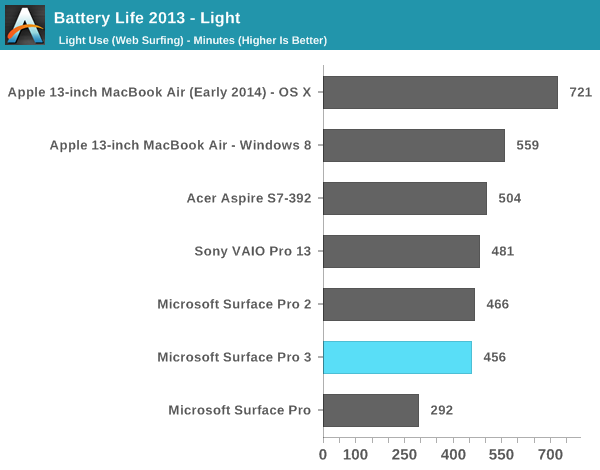

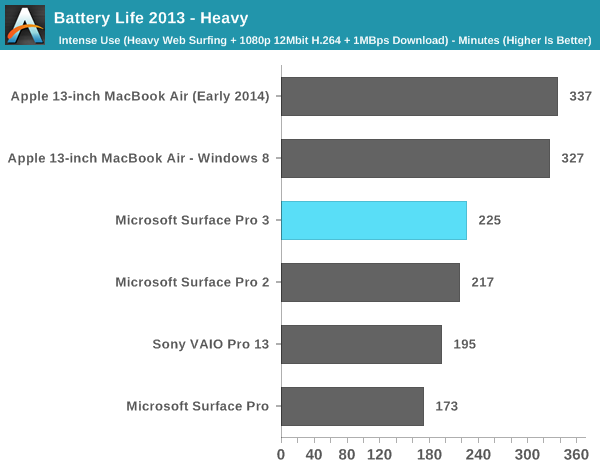
Tablet Battery Life
Tablet workloads are going to be far more display power bound than anything else. Here we see 7.58 - 8.03 hours of continuous usage, a slight regression compared to Surface Pro 2. Video playback remains more power hungry than web browsing, which is something I've noted in previous tablet-evaluations of Intel's Core silicon. I don't believe Intel's Core processors are very optimized for video decode power consumption. If anything is going to change with the move to Broadwell and Core M I suspect video decode power may be it.
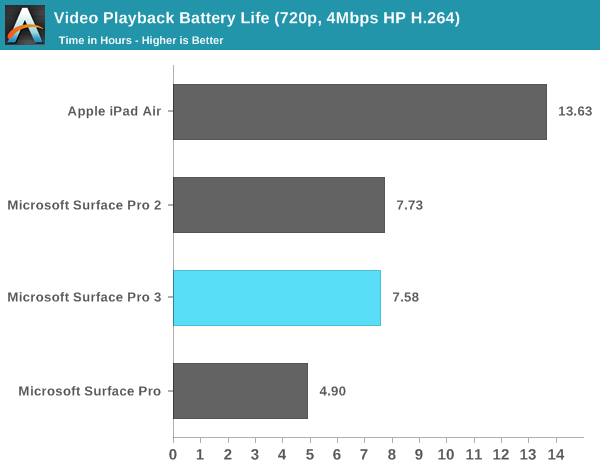
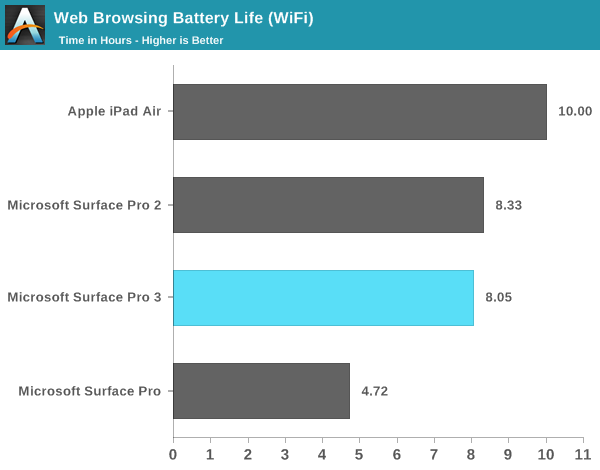


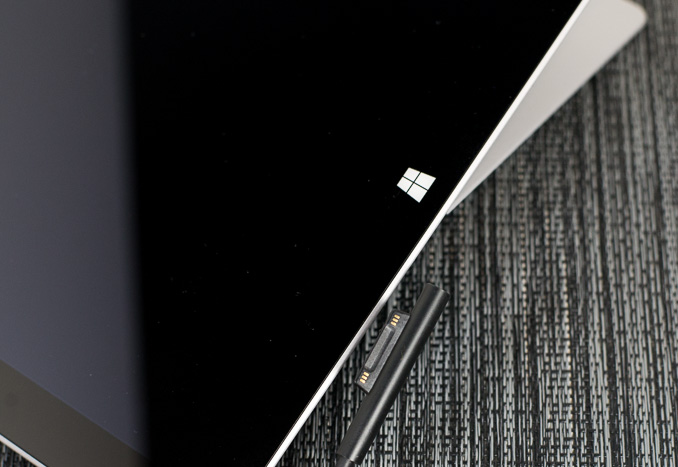
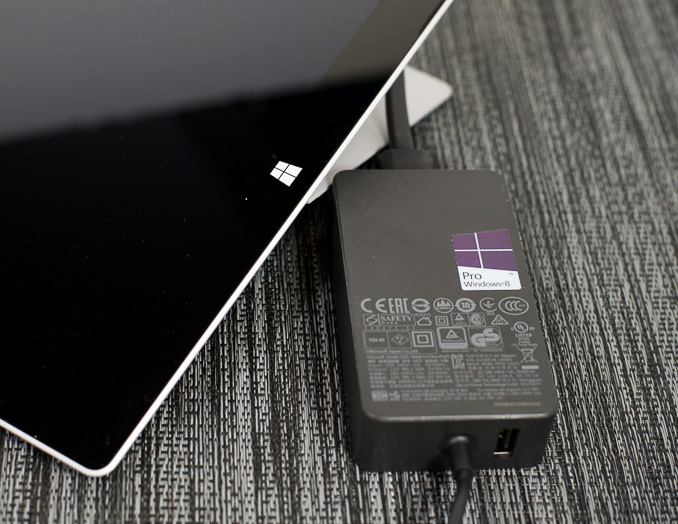








274 Comments
View All Comments
Da W - Monday, June 23, 2014 - link
I use touch on the desktop all the time and it woks well.ablejo26 - Monday, June 23, 2014 - link
You obviously don't know what you are doing on windows 8.1, I switched from mac air with the pro 2 and its way better. If you are not into learning new OS that's fine to stay with the old as it does the job but if want an experience that gives you a touch and type then do it you wont regret it.mmrezaie - Monday, June 23, 2014 - link
Maybe you are right. I am from oss (linux/unix) world, and as far as I am thinking about it, it feels like two distinct os, and not one unified shell. Don't get me wrong, I like the idea very much, but in the end I returned it because I couldn't see it as developer friendly. I use my macbook air a lot since I am always getting remote shell from my servers.basroil - Tuesday, June 24, 2014 - link
"far as I am thinking about it, it feels like two distinct os, and not one unified shell. "In that case you know linux is a schizoid, since bash is completely different to your desktop environment (despite being necessary and also allowing most software to run), and then each desktop environment is different (gnome, KDE, etc). Hell, it's even crazier because you can't actually expect your program to work out of the box on all systems even if they run the same base OS! (mostly because of desktop environment and default packages)
In windows, you have powershell if you need it, and you never NEED to develop for WinRT and Windows.h concurrently.
darwinosx - Tuesday, June 24, 2014 - link
Oh so he's not doing Windows 8.1 the right way...got it.I'll take an Air over the compromised device any day.
kyuu - Tuesday, June 24, 2014 - link
Your Air is a compromised device, as all laptops are. Compromises are made in the name of portability. Calling the SP3 a "compromised" device as though it's some sort of derogatory term is silly. Engineering is all about compromise.Voldenuit - Monday, June 23, 2014 - link
Yeah, $500 to jump to the 8GB/256GB config is pretty steep.$799 for the base model isn't bad, but you're getting severely compromised RAM and storage and a less capable CPU. As Anand says, the type cover needs to be included as standard at all price points, and the higher SKUs are just too expensive for me to stomach (YMMV).
fokka - Monday, June 23, 2014 - link
exactly this. the jump from 256gb to 512gb is $400, while a new 512gb msata evo costs 280 bucks.basroil - Tuesday, June 24, 2014 - link
The 512gb one isn't necessarily an evo, like the 128gb one that sure as hell isn't (hynix unbranded). If they swapped it out for a 840pro or similar I bet you wouldn't be complaining (costs about 400 )tential - Monday, June 23, 2014 - link
I agree with you but this is MSRP launch day prices. Give this a month or two and you'll see much lower prices. I wouldn't be surprised if the model Anand tested for $1299 was $900-1000 In November.